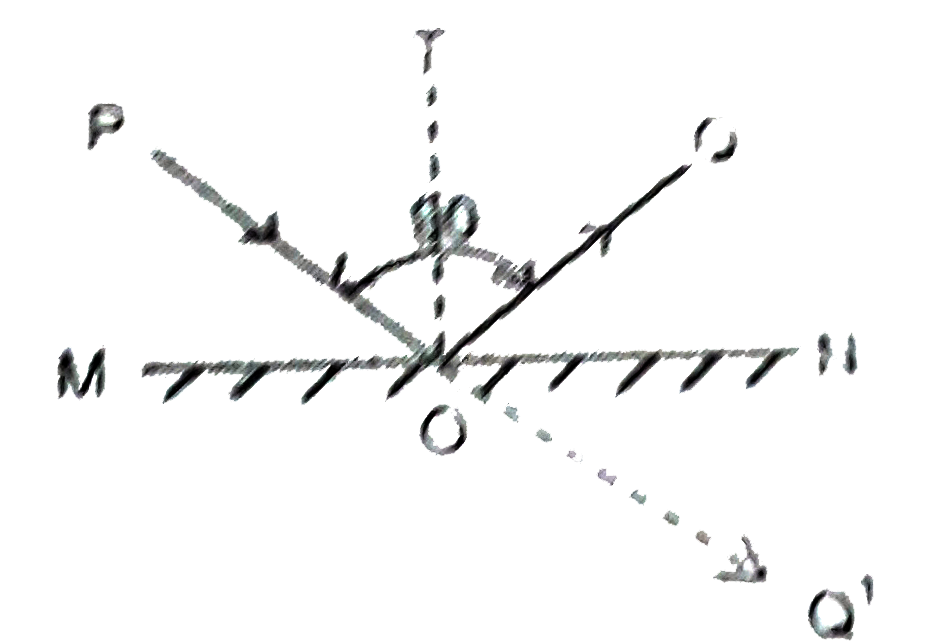A ray of light travelling with a speed c leaves point 1 shown in figure and is reflected to point 2. The ray strikes the reflecting surface at a distance x from point 1. According to Fermat's principle of least time, among all possible paths between two points , the one actually taken by a ray of light is that for which the time taken is the least (In fact there are some cases in which the time taken by a ray is maximum rather than a minimum).
_S01_059_Q01.png)
Under what condition is time taken least?
x= l-x
all of these
The correct Answer is:A
For least time
Topper's Solved these Questions
- GEOMETRICAL OPTICSBook:ALLENChapter:GEOMETRICAL OPTICSExercise:EXERCISE -01
Explore 65 Videos
- GEOMETRICAL OPTICSBook:ALLENChapter:GEOMETRICAL OPTICSExercise:EXERCISE -02
Explore 82 Videos
- GEOMETRICAL OPTICSBook:ALLENChapter:GEOMETRICAL OPTICSExercise:subjective
Explore 14 Videos
- CURRENT ELECTRICITYBook:ALLENChapter:CURRENT ELECTRICITYExercise:All Questions
Explore 427 Videos
- GRAVITATIONBook:ALLENChapter:GRAVITATIONExercise:EXERCISE 4
Explore 9 Videos
Similar Questions
A ray of light is sent along the line which passes through the point (2, 3). The ray is reflected from the point P on x-axis. If the reflected ray passes through the point (6, 4), then the co-ordinates of P are
View SolutionA ray of light passing through the point (8,3) gets reflected after it meets x -axis at (14,0) .Then the equation of the reflected ray
View Solution
Knowledge Check
A ray of light travelling with a speed c leaves point 1 shown in figure and is reflected to point 2. The ray strikes the reflecting surface at a distance x from point 1. According to Fermat's principle of least time, among all possible paths between two points , the one actually taken by a ray of light is that for which the time taken is the least (In fact there are some cases in which the time taken by a ray is maximum rather than a minimum).
_S01_060_Q01.png)
Which of the following statement is in accordance with Fermat's principleAA ray as it moves from one point to another after reflection takes shortest possible pathBA ray as it moves from one point to another after reflection takes longest possible pathCA ray as it moves from one point to another takes shortest possible timeDA ray as it moves from one point to another takes longest possible timeA ray of light travelling with a speed c leaves point 1 shown in figure and is reflected to point 2. The ray strikes the reflecting surface at a distance x from point 1. According to Fermat's principle of least time, among all possible paths between two points , the one actually taken by a ray of light is that for which the time taken is the least (In fact there are some cases in which the time taken by a ray is maximum rather than a minimum).
_S01_058_Q01.png)
Find the time for the ray to reach from point 1 to point 2.A√Y21+x2+√(l−x)2+Y22cBlcCY1c+Y2cD2xcIf a light ray is reflected from a mirror as shown in the figure, then
 Athe glancing angle of light ray is 45∘Bthe reflected light ray is perpendicular to the incident light ray.Cthe reflected light is deviated through an angle of 90∘DAll of the above
Athe glancing angle of light ray is 45∘Bthe reflected light ray is perpendicular to the incident light ray.Cthe reflected light is deviated through an angle of 90∘DAll of the above
A ray of light, coming along the straight line 2x+3y=6, strikes at x -axis and reflects, then the equation of the reflected ray
View SolutionA light ray emerging from the point source placed at P(1,3) is reflected at a point Q in the axis of x. If the reflected ray passes through the point R(6,7), then the abscissa of Q is:
View SolutionIf a light ray is reflected from a mirror as shown in the figure, then

View SolutionPath taken in the eye ball by light rays is
View SolutionWhen a ray of light travelling parallel to the principal axis of a concave mirror strikes at the polished surface of mirror, the reflected ray
View Solution